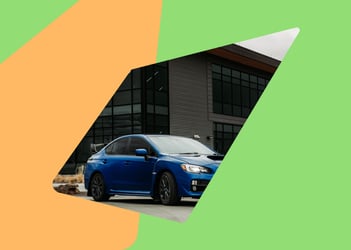- Carmoola
- Blog
- Tips and Advice
- Top Tips on How to Drive Safely in the Snow

Top Tips on How to Drive Safely in the Snow
Snowy conditions can make driving more dangerous, so it’s crucial to make the necessary preparations before you proceed on your journey.
We've got some tips that you can use on how to drive safely in the snow.
Plan Your Trip
Before you head off to your destination, take time to plan for your trip first. Know the routes you’ll take and be updated with the traffic news so you’ll have a smooth time driving.
Check the areas you plan to visit because there might be places that become more dangerous due to flooding, for example.
Don't forget to get updates on the local weather so you’ll know what to expect.
Prepare and Check Your Car
Allocate ample time so you can clear your car mirrors, lights, and windows of snow. Don’t forget to also remove snow from the top of your car.
If you proceed to drive without doing this step, you might end up breaking the law. You might have to de-ice the windscreen as well and clear the mist inside, too.
As you may already know, it’s illegal to drive your vehicle without full visibility through all of the car’s windows.
Consider carrying a lock de-icer on your trip so you can clear the lock if it ever gets frozen while you're on the road.
Check the Tyres
The tyres must have adequate tread depth. If you proceed to drive a car with poor tyres, then they will not grip when you’re driving on ice and snow.
If snowy weather is common in your area, you may want to change your tyres to ones that have deeper tread.
You may also use snow chains or snow socks if the weather conditions become extreme.
Check the Wipers
Before you turn on the ignition to check the wipers, the auto wiper control must be switched off.
If the wipers are stuck frozen on the windscreen, the control fuse might be damaged if it’s forced to move the wipers.
See to it that the wipers are working properly before you head off to your destination so you can clean the windscreen without any problems.
Check the Screenwash
When choosing a screenwash, get good-quality ones that can protect your windscreen and wipers up to -35 degrees. This way, water won’t freeze, and you can continue using your wipers without any problem.
Remember that if the wipers are stuck on the windscreen, you won’t be able to use them, and that would be dangerous for you as you’re driving.
Driving on Snowy Roads
When you accelerate, do so gently. Your revs should be low and then move up to a higher gear quickly.
Change to winter mode or move off to second gear to decrease wheel slip. If you’re not sure if your car has winter mode, you can check the car manual to see if your vehicle has this function.
Keep a Safe Distance
While driving, maintain a steady speed and also keep a safe stopping distance from the car in front of you.
You may want to leave up to ten times the recommended gap for normal weather conditions when you’re driving on snowy roads.
Do the same if you’re driving uphill so that you can keep a constant speed and not have to change gear. Downhill, use low gear so you don’t have to avoid unnecessary braking.
Losing Grip
What if you’re approaching a bend? In this situation, brake before you begin to turn the steering wheel.
If you feel your car starting to lose grip, don’t panic. Remember to remove your foot from the accelerator and that your wheels are still pointing in the direction you intend to go.
In the event of a skid, gently steer into it. See where the rear of your vehicle is heading and then steer in that direction.
Remember not to remove your hands from the steering wheel. Also, don’t press on the brakes.
While this may seem like a very scary situation, don’t let panic overwhelm you; instead, try to manoeuvre the vehicle the best you can.
Using the Right Lights
In heavy snow, make use of the dipped headlights because it’s not enough to use the daytime running light.
This is because you might not have lights on the back of your vehicle. Use your fog lights if you can’t see anything beyond 100m. As soon as visibility gets better, turn it off.
Manoeuvering the Vehicle
Try not to drive in the wheel tracks of other cars because the snow is already compressed in those areas. They’re more likely to be more dangerous to drive on than fresh snow.
When you’re using controls like accelerator, steering, and brakes, do so slowly and smoothly. Even when you’re changing gears, remember not to be abrupt with it.
Takeaway
When driving in the snow, wear comfortable and dry clothing that will keep you warm. This includes your footwear.
You may also want to prepare a pair of sunglasses so you can protect your eyes from the glare of the winter sun reflecting on the snow.
After your trip and you’ve already arrived home, it’s a good idea to clean your car. The salt for de-icing roads can affect your car and cause corrosion if not removed.
Throughout the winter season, clean your vehicle regularly to make sure it works well, and you can reach your destination safely. 👍
Subscribe to get weekly updates, advice and helpful content direct to your inbox
See how much you can borrow in 60 seconds
No impact on your credit profile to see if you're approved 🙌
| Representative Example | |
|---|---|
| Loan amount | £10,000 |
| Interest rate | 13.9% APR |
| 54 payments of | £246 |
| Total cost of credit | £3,284 |
| Option to purchase fee | £1 |
| Total payable | £13,285 |
Recommended Articles
What happens if my car has been written off and it’s still on finance?
Accidents happen. When split-second decisions and challenging conditions make driving difficult at the best of times, even the...
Which credit reference agencies do lenders use?
When applying for car finance, your credit score can make a significant difference to the APR you’re offered, your repayment...
What is negative equity car finance?
Anything with the word ‘negative’ in its name is understandably likely to ring alarm bells, but if you’re one of the many people...


.webp?width=832&height=592&name=customer-support%20(1).webp)








.webp?width=400&height=285&name=online-shoppers-with-dog%20(1).webp)


.jpg?width=500&height=356&name=Vintage%20car%20going%20to%20an%20old%20town-1%20(1).jpg)




